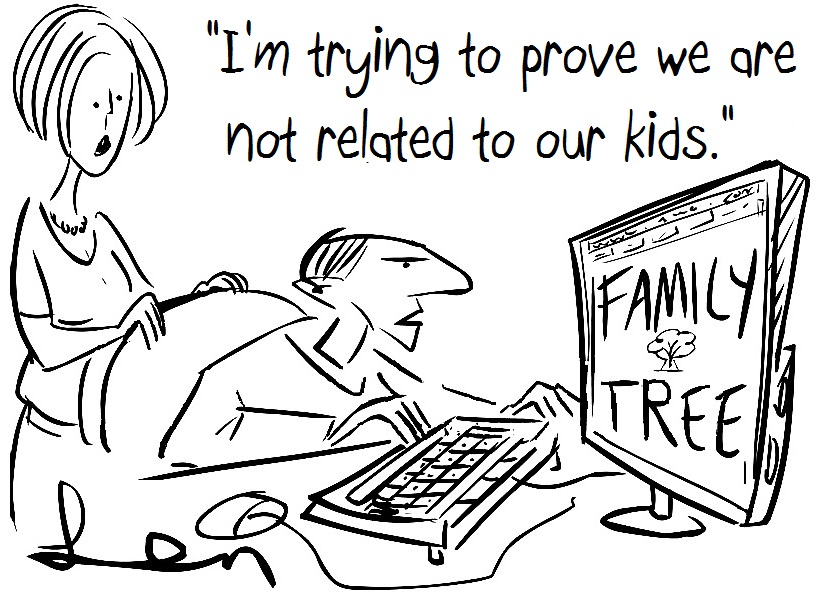|
The
|
THE BURGENLAND BUNCH NEWS - No. 322 August 31, 2021, © 2021 by The Burgenland Bunch All rights reserved. Permission to copy excerpts granted if credit is provided. Editor: Thomas Steichen (email: tj.steichen@comcast.net) BB Home Page: the-burgenland-bunch.org BB Newsletter Archives: BB Newsletter BB Facebook Page: TheBurgenlandBunchOFFICIAL Our 25th year! The Burgenland Bunch Newsletter is issued monthly online. The BB was founded in 1997 by Gerald Berghold, who died in August 2008. |
| Current Status Of The BB: * Members: 3074 * Surname Entries: 9092 * Query Board Entries: 5861 * Staff Members: 13 |
This newsletter concerns: 1) THE PRESIDENT'S CORNER 2) HISTORY, DECAY AND RECONSTRUCTION OF ST. EMMERICH’S CHURCH - by Josef Muszits, translated by Stefanie Schermann 3) HISTORICAL BB NEWSLETTER ARTICLES: - THE 1646 RAID ON NEUMARKT AN DER RAAB (by Richard Potetz) 4) ETHNIC EVENTS 5) BURGENLAND EMIGRANT OBITUARIES (courtesy of Bob Strauch) |
1) THE PRESIDENT'S CORNER (by Tom Steichen)  It
seems that we can't go two months without the Covid story changing, as the deep south now appears to be overrun with the
Delta variant. During my travels this past month (which took me from Pennsylvania to Minnesota and back, and crossed through
Ohio, Indiana, Michigan, Illinois and Wisconsin), I noticed far more masks were being worn than in my PA home area. Perhaps
that had to do with travelers being naturally suspicious of unfamiliar areas, or it may have been increasing local case
counts causing residents to mask up, but it was rather noticeable even though those states are not the current "hot" areas.
Beyond that, it seems evident to me that we are all in for another round of masks and/or booster shots, which I'll undergo,
as I'd rather be safe than sorry. One side effect of the lack of masks these past few months: both my wife and I suffered
our first "common cold" since before Covid arrived... she caught one early in our travels and eventually gave it to me...
and I was still sniffling days after our return! It
seems that we can't go two months without the Covid story changing, as the deep south now appears to be overrun with the
Delta variant. During my travels this past month (which took me from Pennsylvania to Minnesota and back, and crossed through
Ohio, Indiana, Michigan, Illinois and Wisconsin), I noticed far more masks were being worn than in my PA home area. Perhaps
that had to do with travelers being naturally suspicious of unfamiliar areas, or it may have been increasing local case
counts causing residents to mask up, but it was rather noticeable even though those states are not the current "hot" areas.
Beyond that, it seems evident to me that we are all in for another round of masks and/or booster shots, which I'll undergo,
as I'd rather be safe than sorry. One side effect of the lack of masks these past few months: both my wife and I suffered
our first "common cold" since before Covid arrived... she caught one early in our travels and eventually gave it to me...
and I was still sniffling days after our return!This month's bits and pieces (Article 1) has four bits direct from Burgenland. The first concerns the election of a new BG President, the second reports that Burgenland recently grew in size (strange, I know, so read the bit!), the third explains about a highway that will not be (though I wonder about the future implications of that decision for the local community roads, which were already overwhelmed with through-traffic!), and the fourth is about a response to rising concern about refugees who may carry a Covid infection. I also include a bit about a new marriage record transcription for Großpetersdorf, courtesy of Patrick Kovacs. Then we have our regular tidbit features, a monthly update on corona-virus happenings in Burgenland, the monthly BB Facebook report, book sales, a recipe and a cartoon-of the month. Article 2 is a reprint of an article that first appeared on the BB Facebook page. It was written in German by Josef Muszits of Burgenland and translated to English by his granddaughter, Stefanie Schermann, a member of our BB Facebook group, who shared it there. Titled, History, Decay and Reconstruction of St. Emmerich’s Church, it provides research into the history of the church and first-person memories of its later decay and eventual reconstruction. Another Facebook member proposed that it also appear in the BB Newsletter so, with permissions obtained, here it is. The remaining articles are our standard sections: A Historical BB Newsletter article, Ethnic Events and Emigrant Obituaries. 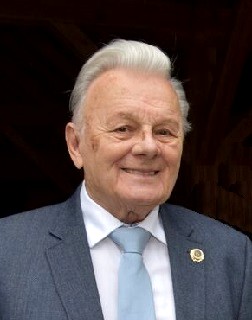 New
BG President: As expected, the Burgenländische Gemeinschaft (BG) elected a new President in July to
replace 89-year-old Dr. Walter Dujmovits, who resigned from the office of President after serving in that role
for 36 years among his 63 years with the BG. Walter was immediately appointed Honorary President in recognition of
his years of service. New
BG President: As expected, the Burgenländische Gemeinschaft (BG) elected a new President in July to
replace 89-year-old Dr. Walter Dujmovits, who resigned from the office of President after serving in that role
for 36 years among his 63 years with the BG. Walter was immediately appointed Honorary President in recognition of
his years of service.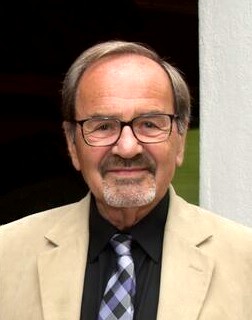 The
new President is Eduard Nicka, a retired teacher and member of the Burgenland parliament from Bad
Tatzmannsdorf. Eduard has been a long-standing member of the BG board, most recently taking the leadership reins when Walter
was hospitalized. The
new President is Eduard Nicka, a retired teacher and member of the Burgenland parliament from Bad
Tatzmannsdorf. Eduard has been a long-standing member of the BG board, most recently taking the leadership reins when Walter
was hospitalized. In his new role, he stated that he "wants to continue the idea of the Burgenländische Gemeinschaft" but recognizes that the "general conditions are becoming increasingly difficult - especially the meetings with the following generations of Burgenland emigrants." He noted that the connections are still there, "but mostly over the Internet," in particular mentioning the "close contact with the Internet portal 'Burgenland Bunch'.” Erwin Weinhofer from Glasing, Anton Huber from Güssing and Joe Baumann from New York were also elected as his deputies (Vice Presidents) at the general assembly in Moschendorf.  Burgenland has grown bigger:
For the first time since 1043 AD, the historical, Lafnitz River-based border between current-day Burgenland
and Styria has changed. This is a result of "regulatory" changes made to the river starting in the 1970s that were designed
to reduce flooding near Burgauberg / Neudauberg (Güssing district) and Neudau (Hartberg-Fürstenfeld district in Styria). The
regulatory measures straightened the Lafnitz in the area, piercing the old river bends, the meanders, with the result that
Styria was partly on the left bank (the east side of the river) and Burgenland was partly on the right bank (west side) of
the new river course. Burgenland has grown bigger:
For the first time since 1043 AD, the historical, Lafnitz River-based border between current-day Burgenland
and Styria has changed. This is a result of "regulatory" changes made to the river starting in the 1970s that were designed
to reduce flooding near Burgauberg / Neudauberg (Güssing district) and Neudau (Hartberg-Fürstenfeld district in Styria). The
regulatory measures straightened the Lafnitz in the area, piercing the old river bends, the meanders, with the result that
Styria was partly on the left bank (the east side of the river) and Burgenland was partly on the right bank (west side) of
the new river course.In the map to the right, the old river course/border is shown in red, the new course/border in dark blue, with areas between the lines changing governments. According to the mayor of Neudau, Wolfgang Dolesch, "We decided at the community level in 2010 in Burgauberg-Neudauberg, in Burgau and in Neudau, to make concurrent local council resolutions and stipulate that everything that is left bank should be Burgenland and everything that is right bank is Styria." While it has taken years for the resolutions to make their way through the various government levels and become official, the net result is the state borders have now been changed and Burgenland officially grew by 6,000 square meters (~150 acres) at the expense of Styria. Burgauberg-Neudauberg mayor, Wolfgang Eder, notes that, “We live here on one of the oldest borders in Europe and in the past the border has always meant a war or a conflict. We have now grown by 6,000 square meters, but it was not a hostile conquest, on the contrary, we are supported by our Styrian friends, the Burgauer and the Neudauer.” Being in the flood plane, the areas changing hands were uninhabited, meaning no one had to be relocated nor were the acres greatly valued, which made the process easier. A3 will not be extended: The controversial extension (< 4 miles) of the southeast motorway (A3) to the border near Klingenbach (Eisenstadt-Umgebung district) will not be carried out. The project will not be implemented due to the effects on the soil and climate, said Environment and Transport Minister Leonore Gewessler (Greens) on Monday.  The
evaluation of the entire ASFINAG construction program will continue until autumn, but the result of the project in
Burgenland is already available, according to the climate protection ministry. With the A3 extension around 60 hectares (150
acres) of soil would be sealed, the consequences for soil and climate would be "dramatic", emphasized Gewessler. The
evaluation of the entire ASFINAG construction program will continue until autumn, but the result of the project in
Burgenland is already available, according to the climate protection ministry. With the A3 extension around 60 hectares (150
acres) of soil would be sealed, the consequences for soil and climate would be "dramatic", emphasized Gewessler.In addition, realizing the project would mean an increase in traffic, especially in transit traffic from abroad. This in turn would lead to a high level of exposure to noise and bad air for the population. Completion would be expected in 2030 at the earliest. The project, for which planning was started around 20 years ago, is also controversial in Burgenland. In 2018, the state parliament asked the federal government not to pursue it any further. In 2020, Governor Hans Peter Doskozil (SPÖ) renewed the demand. “We are now complying with this request. ASFINAG will no longer pursue the A3 in the construction program of the future. Instead, we will quickly look for better alternatives with the Province of Burgenland,” said Gewessler. A working group is to develop alternatives, such as an improvement in public transport and targeted expansions in the low-level road network. The Greens in Burgenland are enthusiastic about this decision: Environment Minister Leonore Gewessler is killing two birds with one stone: The soil sealing that the expansion of the motorway would have required can be prevented and the neighboring communities receive an ecologically sensible, local traffic concept, according to the club chairwoman of the Green Burgenland Regina Petrik. 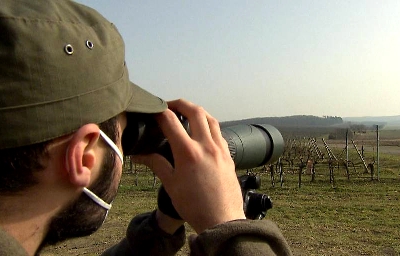 Border
Covid Protection Being Strengthened: In late August, the Burgenland state police informed mayors in towns along the
middle-Burgenland border that the federal army will be assisting in monitoring the border and in detaining refugees before
they make their way into their towns. Thus there will be increased surveillance in the municipalities and border areas of
Deutschkreutz, Nikitsch, Croatian Minihof, Lutzmannsburg and Frankenau (all are along the border south of Sopron, Hungary). Border
Covid Protection Being Strengthened: In late August, the Burgenland state police informed mayors in towns along the
middle-Burgenland border that the federal army will be assisting in monitoring the border and in detaining refugees before
they make their way into their towns. Thus there will be increased surveillance in the municipalities and border areas of
Deutschkreutz, Nikitsch, Croatian Minihof, Lutzmannsburg and Frankenau (all are along the border south of Sopron, Hungary).With the increase in Covid variants, there is rising concern and uncertainty among the population when residents are approached by refugees, said police spokesman Helmut Marban. The goal is to pick up refugees in the green space near the border, thus avoiding population centers, and transport them to one of the three processing centers in Nickelsdorf, Schattendorf and Heiligenkreuz. A corona virus test will be carried out there and data collected from the refugees with the help of an interpreter, according to the police. Großpetersdorf Catholic Marriage Records: BB member Patrick Kovacs has provided a transcription of Großpetersdorf Catholic marriage records for the years 1828 to 1895 that consists of the complete transcription of the 1211 marriage records. Copyright remains with Patrick. He previously contributed a transcription of Großpetersdorf civil recording district marriage records for the years 1895 to 1920, which consisted of the complete transcription of the 530 marriage records. Name spellings (both surname and given names) have been standardized in these datasets to allow easier searches; you should check the original image for the exact form that appears in the records [standardized means only that a single form of a given name, or of what is believed to be the same surname, is used in the records, regardless of what was recorded]. Großpetersdorf was also known by the Hungarian names Nagy-Szent-Mihály and Nagy-Német-Szent-Mihály, the Croatian name Veliki Petrštof and the Romanes name Simeha. The Großpetersdorf Catholic Parish included itself and the villages of Jabing (before 1852 only), Kleinpetersdorf (after 1858 only) and Miedlingsdorf.  Corona
Virus in Burgenland: There was little significant Covid-related news this month from Austria. It lifted entry
restrictions for travelers arriving from the United States in June but proof of vaccination, proof of recovery from COVID-19
or a negative Covid-19 test result must still be presented upon entry into Austria. Travel through certain countries or
arrival from an area with a known "variant" outbreak will require additional measures. Many public places also require
similar proof and may require registration for entry, so tracing can be done if an issue occurs. Corona
Virus in Burgenland: There was little significant Covid-related news this month from Austria. It lifted entry
restrictions for travelers arriving from the United States in June but proof of vaccination, proof of recovery from COVID-19
or a negative Covid-19 test result must still be presented upon entry into Austria. Travel through certain countries or
arrival from an area with a known "variant" outbreak will require additional measures. Many public places also require
similar proof and may require registration for entry, so tracing can be done if an issue occurs. Infections still occur in Burgenland, though the numbers remain low, and Burgenland continues to be the Austrian state with the highest vaccination rate, with over 60% fully or partially vaccinated. 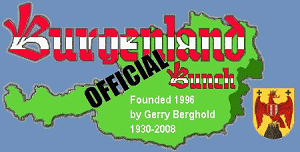 The
Facebook Bunch (from Vanessa Sandhu): The
Facebook Bunch (from Vanessa Sandhu):Greetings Burgenland Bunch! Member Gerhard Franz shared some photos from his visit to Burg Schlaining and showcased the “100 years of Burgenland “ exhibition. My cousin Terry (Gabriel) Hurst played “Im Burgenland, do steht unsa Haus” on her button box for us. The button box was passed down from her godfather to her uncle and then to Terry. It is over 100 years old. Terry learned to play from her father, Joseph Gabriel of Woppendorf. The music was enjoyed by all! Member Steffi shared a detailed history of St. Emmerich’s Church, located in Inzenhof in southern Burgenland. The history was written by Steffi’s grandfather, Josef Muszits, who still resides in Inzenhof. Member Peter Michael Lang shared photos of priest Josef Bartl and gave some additional facts relating to St. Emmerich’s. Member Roland Schuller shared his recipe for an Austrian pancake, the original Kaiserschmarren. The subtitles are in English, so give this a try! It is delicious! https://youtu.be/e6-owU113Jw I made a YouTube channel featuring clips from past Lehigh Valley Burgenland ethnic events. There are several events on the channel now and I plan to add more as they happen. It is a work in progress, so it is far from perfect. For anyone interested, here is the link: https://m.youtube.com/channel/lvevents Member Brien Vokits shared grave markers from Durnbach, a village near Schandorf and Schachendorf. For those looking for a fun Oktoberfest, look no further than the Coplay Sängerbund! The “Bund” will be hosting its Oktoberfest on Sunday, September 12, 2021. The event is OPEN TO THE PUBLIC. Admission is $5 per person. The opening parade will begin at 2:30 pm. Music will be provided by our own Josef Kroboth. The Auerhahn Schuhplattler Dancers will be providing the entertainment. The Button Box Committee will also perform. There will be a sing-a-long and a Maßkrugstemmen (beer stein holding) contest. There will be authentic ethnic foods and beer. We hope to see you there! That’s all for now! Stay safe and healthy! Vanessa  Update
for book "The Burgenländer Emigration to America": Here is this month's update on purchases of the English issue of
the 3rd edition of Dr. Walter Dujmovits' book "Die Amerika-Wanderung Der Burgenländer." Update
for book "The Burgenländer Emigration to America": Here is this month's update on purchases of the English issue of
the 3rd edition of Dr. Walter Dujmovits' book "Die Amerika-Wanderung Der Burgenländer."Current total sales are 1615 copies, as interested people purchased 7 more books during these past two months. For curiosity, I looked closer at the current sales data. Of all books sold so far, over 90% were purchased with US dollars, nearly 7% with euros, and just over 2% with Canadian dollars. The remaining half-percent of sales were split between Australian dollars and British pounds. These percentages are not surprising, as the book is in English and, with the exception of the euro purchases, the currencies correspond to English-speaking countries. Further, the euro sales were driven (~90%) by purchases made by the Migration Museum in Güssing, which targets English-speaking visitors with this version (they also carry the German-language original). As always, the book remains available for online purchase at a list price of $7.41 (which is the production charge for the book, as we purposely choose not to make a profit so we can avoid dealing with the income tax consequences and so you can obtain the book at as low a cost as possible!), plus tax & shipping. See the BB homepage for a link to the information / ordering page and for information about current discounts (there is at least one discount on price or shipping available most of the time... if not, wait a few days and there will be one!). Getting the book and reading it is an excellent way to pass the time should the coronavirus impose yet another round of "house arrest" ...and even if not "arrested," it should still prove to be informative! Burgenland Recipes: This recipe comes from Marci Hessinger, whose grandparents are from Kukmirn. She previously shared her recipe for Husarenkrapfen with us. Palatčinke (Pancakes with Fruit Filling) (from Marci Hessinger) Makes 8 pancakes  Batter
& Filling Ingredients: Batter
& Filling Ingredients:2 eggs 6 Tbsp unsalted butter, softened 1 cup milk 1 Tbsp oil 1 tsp vanilla 1 cup flour lekvar (prune butter) or other desired jam or filling powdered sugar Preparation: In a mixer, beat the wet ingredients together then add flour to make a smooth, thin batter.
Pour a scoop (1/4 to 1/3 cup) into a hot, medium-sized skillet (8") and swirl it around (off the
heat) to fill the pan. |
2) HISTORY, DECAY AND RECONSTRUCTION OF ST. EMMERICH’S CHURCH - by Josef Muszits, translated to English by granddaughter Stefanie Schermann [Editor: This article first appeared on the BB Facebook page, prompting a Facebook page member to propose that it also be published in the BB Newsletter, a proposal that met with the approvals of Josef, Stefanie and myself, so here it is...] Josef writes: The first time St. Emmerich’s church was mentioned in a document was in 1336. From a Latin translation we know that the valley approaching the church (coming from the direction of Inzenhof / Borosgödör) was called "Wohlfahrtswewige" ("Wallfahrtstal," in English "pilgrimage valley"). This means it was already known as a pilgrimage church back then. The church’s name comes from the son of Hungarian King Stefan, "Emmerich." The church stands on Hungarian national territory, even if only a few meters away from Austrian border. Emmerich was canonized by the then-Pope and the church was named after him. During the Thirty Years War (1618-1648), the church was a Lutheran one. Count Adam Batthyány gave it back to the Catholics in 1634. The church freely stood on a hill, visible from afar. In 1898, a storm almost destroyed the roof. The building's unfortunate condition followed, and it will be discussed in more detail below. 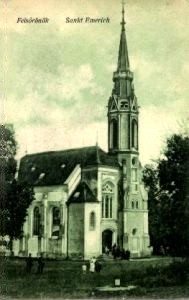 The
pastor at that time (Josef Bartl, he was from Lockenhaus / Léka) decided to demolish the church and build a new one. The
plans for the new, current building came from an imperial and royal court ("k.u.k.") architect from Vienna, who back
then had planned several churches in the West Hungarian area (to which the Burgenland of today belonged). [Editor:
Presumably, this refers to the Viennese architect Ludwig Schöne. Other sources attribute the design to Sándor Baumgarten, a
well-known architect from Budapest who specialized in schools and large residential buildings.] The newly-built church
was consecrated on Whit Monday in 1904. This feast of consecration is celebrated to this day as the so-called "Kirtag"
at Pentecost. The
pastor at that time (Josef Bartl, he was from Lockenhaus / Léka) decided to demolish the church and build a new one. The
plans for the new, current building came from an imperial and royal court ("k.u.k.") architect from Vienna, who back
then had planned several churches in the West Hungarian area (to which the Burgenland of today belonged). [Editor:
Presumably, this refers to the Viennese architect Ludwig Schöne. Other sources attribute the design to Sándor Baumgarten, a
well-known architect from Budapest who specialized in schools and large residential buildings.] The newly-built church
was consecrated on Whit Monday in 1904. This feast of consecration is celebrated to this day as the so-called "Kirtag"
at Pentecost.The financing for this new building partly came from the Hungarian religious fund and from the residents of the former parish of St. Emmerich. Manual hauling and lifting work was also done by the former parish members. According to professional judgment, the church doesn't have the appearance of a village church, but rather looks like a small basilica. Behind the church there was a German elementary school. The children of Inzenhof / Borosgödör and Tschanigraben / Sándorhegy once attended it too; later those villages got their own schools. Until 1893, the dead of both villages were buried at the cemetery near St. Emmerich’s church. According to a document about the Croatian parish St. Nikolaus bei Güssing / Vár-Szent-Miklós of 1750, a procession to the church took place every year on Whit Monday. The following villages were originally part of St. Emmerich’s parish: Felsörönök and Alsórönök (Oberradling and Unterradling, today known as Rönök / Radling), Jakabháza (Jakobshof) and parts of Rábafüzes (Raabfidisch), as well as Inzenhof and Tschanigraben. The parish was divided when the border was drawn in 1921. Inzenhof and Tschanigraben became part of Austria. The other three villages stayed in Hungary, although the population there was almost 100% German, which had devastating consequences later on (forced resettlement and displacement). Religious life in Inzenhof and Tschanigraben changed because of this. The pastor of St. Emmerich‘s (called "Bartlpfarrer" by the locals) still came to Inzenhof’s elementary school for religion class. Baptisms, first communion, confirmation for the children, weddings and funerals were carried out by pastor Bartl until 1938. He died in 1946 and was buried at the cemetery of his former church. Despite the church standing in a combat area for almost three weeks in 1945, it suffered little damage. In 1946, more than 700 people from the three villages of Rönök, Jakabháza and Rábafüzes were expelled from their property in Hungary. They were forced to leave within a few hours, allowed to have carry-on baggage only, were taken to the train station and then were resettled in Germany. There were harrowing scenes, some people even got arrested because they couldn't believe it was possible to be expelled from your own home and property. Some were able to flee to Austria, where they found a new home. Along the train stations on Austrian side you could hear people cry and scream. Attached to the back of St Emmerich’s church today is a memorial plaque for all these people. The houses of these locals were destroyed and the church today seems to stand inside a forest, not like once, as it could be seen from afar in a blooming landscape. From 1949 to 1950 the Iron Curtain ("Eiserner Vorhang") was built along the border. Barbed wire, mine field and again barbed wire. In the following years the persecution of the Catholic faith community in Hungary began. Cardinal Mindzenty had to flee into the Austrian embassy in Budapest to avoid arrest. The pastor of St. Emmerich‘s [Editor: János Komíves] was visited by two state police officers. They presented him a document and wanted him to sign. He refused because the content wasn't true. In the next days the Hungarian soldiers who were stationed at the border told him he would have to expect arrest and would only be able to avoid it if he'd flee. Easier said than done. At the same time they told him that the paths at the church leading to Austria were heavily mined. The back-then still-young priest was almost desperate. He didn't want to leave the church he was entrusted with. On the other hand, he feared for his life. So he decided to flee. He lit candles inside the church because there should have been a mass in the evening and it was already almost dusk. Then he took combination pliers, went some meters on the Hungarian side along the barbed wire in direction of Inzenhof, cut open the barbed wire and then stepped into the mine field. After passing some meters, he heard a noise he couldn't assign at first. Was it a slight crackling or a whistling? He looked down and between his feet there was a mine. As if God led him, he dodged the mine and was able to walk across the rest of the mine field unharmed. When he arrived on the Austrian side he cut open the barbed wire again and then walked over to a big lime tree. There he kneeled down and prayed. Then he went along the former way through the forest, today a freight route (="Güterweg" in German, a small road off the main road), in the direction of Inzenhof. Near the cemetery of Inzenhof he met a man. It was the farmer Mr. Kroboth, who was looking at his fields at that time. He turned to Mr. Kroboth, but he couldn't speak a single word in German, so he used a dictionary and wrote onto a piece of paper that he was the pastor of St. Emmerich’s ("Bin Pfarrer von St. Emmerich"). The man took him home. His wife was from Raabfidisch / Rábafüzes and she spoke a little Hungarian. The couple had three children. They told them to please behave because they would go away for two or three hours. With a storm lamp, the three of them, Mr. Kroboth, his wife and the pastor, went to Heiligenkreuz / Rábakeresztúr to the local pastor. They couldn't use the road because, for about one kilometer, it was border land—the Hungarian border soldiers could have arrested the refugee at any time. This would have sealed his fate. So they used paths in fields, in forests and in meadows to take him to Heiligenkreuz safely. The other pastor borrowed a bicycle from a neighbor. Together, both pastors went to Fürstenfeld / Fölöstöm, while Mr. and Mrs. Kroboth went back home. Their route to Fürstenfeld also had to be on detours and back roads, because the main road was controlled by Russian occupation forces back then. Finally, both arrived safe and sound in Fürstenfeld. St. Emmerich’s pastor found shelter at the order of St. Severin and was safe. He then spent some time in Graz and afterwards more than 30 years as a priest in Augsburg, Germany. Now St. Emmerich’s church was abandoned to decay. The rectory, agricultural side buildings, and school by the church were demolished. The last teacher working there, Mr. Hoffmann, became a victim of the forced resettlement. After the main altar and both side altars were removed, the church was used as a horse stable, because the Hungarian units were equipped with horses. The statues of the saints became targets. Hungary actually wanted to remove the whole church but Inzenhof and Tschanigraben had ownership shares, which meant the church was also Austrian property, so this was not possible. 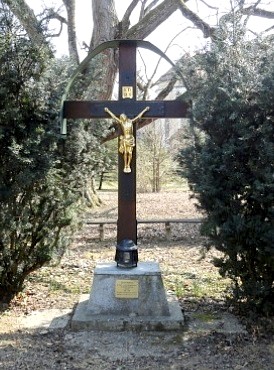 In
the 60's of the last century, two officers from the customs guard post in Großmürbisch (Nagymedves) exercised their service
at St. Emmerich’s church. When they were back at their post, a deadly accident happened when they put down their weapons and
one of the officers died. Because of this incident and a customs guard anniversary, the head of department of Inzenhof
ordered putting up a cross at the church. It is called "Zöllnerkreuz" = "Customs Officer Cross". With his
action he wanted to call attention to the building, which had become a ruin in the meantime. In
the 60's of the last century, two officers from the customs guard post in Großmürbisch (Nagymedves) exercised their service
at St. Emmerich’s church. When they were back at their post, a deadly accident happened when they put down their weapons and
one of the officers died. Because of this incident and a customs guard anniversary, the head of department of Inzenhof
ordered putting up a cross at the church. It is called "Zöllnerkreuz" = "Customs Officer Cross". With his
action he wanted to call attention to the building, which had become a ruin in the meantime.The cross was inaugurated by then-pastor Stipi Silic of Großmürbisch (Nagymedves). Every year on Whit Monday (because it was consecrated on this day, as mentioned before) from 1979 on, as well as on the national holiday, a holy mass took place at St. Emmerich’s church. Hundreds of people joined this mass at the Iron Curtain. These crowds had to be reported to the Hungarian authorities. On the Hungarian side, soldiers with guard dogs were positioned. Many people from all social classes, representatives of the political parties, high officials from finance and customs, representatives of public life and the police as well as high ecclesiastical dignitaries were there. Even bishop Stefan Laszlo arrived two times. Of course conversations mainly were about the reconstruction of the church. It was clear that the funding wouldn't be the main problem, but the authority channels within the Hungarian government would be. After the mass there was an "Agape" (a common meal after a church service) organized by the Catholic Women Movement under the direction of Mrs. Elfriede Jaindl. They brought a banner with them that said "Faith has no limits" and it was highly appreciated. The two armed soldiers standing inside the tower of the church at the time were a huge contrast to the peaceful atmosphere. 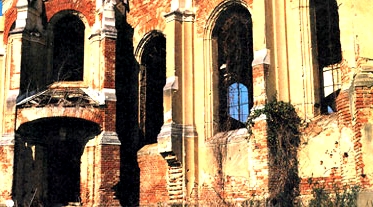 The church’s current state was the
main topic for the many guests. The roof had collapsed and wild growth had taken over in it. A reconstruction was doubted by
many people. Mrs. Jaindl also joined a discussion group and she explained "I will rebuild this church!" After she
said this, people looked at her staggered. One of them said "Elfi, if you accomplish that, this is your life’s work."
Mrs. Jaindl then established contact with the Hungarian government and church offices via the Austrian Foreign Ministry.
Foreign Minister Dr. Mock helped her a lot with this. The church’s current state was the
main topic for the many guests. The roof had collapsed and wild growth had taken over in it. A reconstruction was doubted by
many people. Mrs. Jaindl also joined a discussion group and she explained "I will rebuild this church!" After she
said this, people looked at her staggered. One of them said "Elfi, if you accomplish that, this is your life’s work."
Mrs. Jaindl then established contact with the Hungarian government and church offices via the Austrian Foreign Ministry.
Foreign Minister Dr. Mock helped her a lot with this. It happened afterwards that Mrs. Jaindl had a couple of meetings with the bishop and his employees in the town of Szombathely ("Steinamanger" in German). One time when she was there for a meeting—she always had a priest with her who had the function of an interpreter—she was left with three of the bishop’s employees because her interpreter had to go to Budapest very early. Suddenly there was a knock at the door and a man came inside and greeted them in Hungarian. Mrs. Jaindl then answered that she didn't speak Hungarian. He then greeted her in German. One of the three employees explained to Mrs. Jaindl that the person in front of her was the last pastor of St. Emmerich’s, who had fled over the mine field. The surprise was huge. The repeated greeting was very warm and touching. The pastor mentioned "God sent you" all the time. You need to imagine his escape through the Iron Curtain to avoid being arrested, it could have all ended differently. He had to leave the church God had entrusted him with and had to watch from a foreign country how his church became a ruin. And now there is this woman standing in front of him who wants to reconstruct a church—his church. After the warm greeting, his first question was what had happened to the family that once helped him flee. He was worried that they could have been sentenced because they supported him. The family he still remembered after 30 years used to live in Inzenhof back then. Mrs. Jaindl told him that they were fine but that they had moved away to Vienna. He then was calmed. In the meantime, he had become a citizen of Germany and was allowed to enter and exit Hungary as he liked. According to information from the Austrian Foreign Ministry, the negotiations with the Hungarian authorities brought the following result: Access to the church was granted in the time between 06:00 am and 18:00 pm, but it was forbidden to walk or drive further inland. Then the year 1989 came and the Iron Curtain was finally history. Despite Burgenland’s bishop being a supporter of St. Emmerich’s rebuilding, his employees didn't always share his opinion, because it was also about co-financing, negotiations and meetings with the diocese, until a positive result was achieved. Now the more difficult part of the church reconstruction started for Mrs. Jaindl. From the Austrian side the club / society "Rettet die St. Emmerichskirche" ("Save St. Emmerich’s church") was founded and she became the chairwoman. The society was the contact point for donations from home and abroad. As the displaced residents of St. Emmerich parish got to know that their former church was about to be rebuilt, financial contributions from many countries, as well as from overseas arrived. The once-pastor of St. Emmerich’s also participated in the donations with a large sum he gave to Mrs. Jaindl. He had accumulated a certain amount because he had always believed in the reconstruction of his church. The rebuilding itself was handed over to a Hungarian company because the cost for the Hungarian workers was much less. The Austrian guild master of tinsmiths and roofers did all the individual work (gutters, tower cladding) on his own and also provided the material free of charge. He was from Carinthia and often visited the church with his wife. Mrs. Jaindl was responsible for the whole organization. Parts of the roof structure were donated from the estate management of Graf (Count) Draskovich and taken to the construction site by trucks. The guild master of goldsmiths in Vienna donated the tower cross. Mrs. Jaindl herself took it to Hungary on the occasion of a papal visit, where it was blessed and consecrated by the Pope. One-third of the financing was done by the diocese of Szombathely, one-third by the diocese of Eisenstadt (Burgenland) and the other third by the club Mrs. Jaindl had founded. The once-fled pastor also visited the construction site once in a while and showed his pleasure about the rapid reconstruction. In his hometown of Ödenburg (near the north of Burgenland) he celebrated his "Golden Jubilee" of priests, where Mrs. Jaindl was also present. A week later the celebration was repeated at St. Emmerich’s church. The married couple from the past that had helped him flee (the Kroboths), had moved from Inzenhof to Vienna in the meantime. Unfortunately Mr. Kroboth had already passed away, but Mrs. Kroboth followed the invitation to Inzenhof. After the holy mass, Mrs. Jaindl went to the lectern, thanked the pastor with impressive words and then she surprisingly introduced him to the woman from his past. He raised his hands and you could hear the words "My God, my God" all the time. He hugged the woman a few times and almost cried (you cannot describe such scenes with words, you have to see and experience it yourself). Since the access to St. Emmerich’s church was only possible through a little dirt road from the direction of Inzenhof, 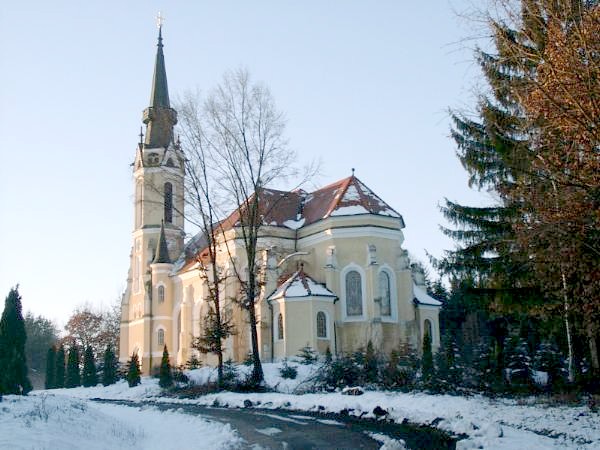 Mrs.
Jaindl had a meeting with the then-governor of the Burgenland, Mr. Karl Stix, and she was promised that he would provide a
certain amount of money for the expansion of the road to the border (as part of a special grant). The village of Inzenhof
carried it out as a part of the "Güterweg" construction program. Land and forest owners were also happy about the
expansion. Mrs.
Jaindl had a meeting with the then-governor of the Burgenland, Mr. Karl Stix, and she was promised that he would provide a
certain amount of money for the expansion of the road to the border (as part of a special grant). The village of Inzenhof
carried it out as a part of the "Güterweg" construction program. Land and forest owners were also happy about the
expansion. The church itself is visited by many people throughout the year, no matter if they come by bus, car, bike, horse or walk there. Many of the displaced residents, as well as their descendants, visit St. Emmerich’s when they come to Austria to remember their old homeland. The church has also been a marriage location for many couples in the meantime. © Stefanie Schermann, A-7571 Rudersdorf |
3) HISTORICAL BB NEWSLETTER ARTICLES Editor: This is part of our series designed to recycle interesting articles from the BB Newsletters of past years. The entry below is the initial two paragraphs from an article from 10 years ago. The original article is quite long—in fact, we originally presented it in two parts in August and September, 2011. As I have done in the recent past, I present these paragraphs as a teaser (clickbait in current terminology!) to the whole article, to which I include links below. So if this teaser sparks your interest, you have an easy path to it. THE BURGENLAND BUNCH NEWS No. 212 August 31, 2011 THE 1646 RAID ON NEUMARKT AN DER RAAB (by Richard Potetz) In 1644, Ottomans in a fortress located in Nagykanizsa, Hungary, sent a letter to Neumarkt an der Raab demanding a delegation come to pay homage. The letter threatened to plunder and destroy Neumarkt if homage was not paid. The people in Neumarkt were told by their lord, Count Adam Batthyány, not to respond to the demand. Instead, Batthyány sent soldiers to protect the village. Two years later, on 7 March 1646, a raid killed 21 inhabitants, burned 25 houses and took 199 people into slavery. As the Ottoman and Hapsburg Empires struggled for dominance, Neumarkt an der Raab was raided several times by both sides. This particular raid is interesting to examine because details have become available. A letter written to Count Adam Batthyány listing the damage done by the raid provides a window into the lives of our not-so-ancient ancestors. Part 2 of this article, in the September newsletter, will contain an English language translation of the old letter.  Map of Neumarkt an der Raab area - with mentioned places indicated For more, see: Part 1: Newsletter 212, Article 4 Part 2: Newsletter 213, Article 4 |
4) ETHNIC EVENTS (slowly opening again!) LEHIGH VALLEY, PA Friday, Sep. 3: Maria & John at the Reading Liederkranz. Info: www.readingliederkranz.com. Sunday, Sep. 5: The Jolly Bavarians at the Coplay Sängerbund. Info: www.coplaysaengerbund.com. Sunday, Sep. 12: Oktoberfest at the Coplay Sängerbund. Entertainment by the Josef Kroboth Orchestra and the Auerhahn Schuhplattler Verein. Info: www.coplaysaengerbund.com. Friday, Sep. 17: The Alpenländers at the Reading Liederkranz. Info: www.readingliederkranz.com. Friday-Sunday, Sep. 17-19: Oktoberfest at the Lancaster Liederkranz. Info: www.lancasterliederkranz.com. Sunday, Sep. 19: The Emil Schanta Band at the Coplay Sängerbund. Info: www.coplaysaengerbund.com. Saturday, Sep. 25: Oktoberfest at the Alliance Fire Co. in Northampton. Music by the Josef Kroboth Orchestra. Info & tickets: (484) 951-6140. Sunday, Sep. 26: The Dave Betz Band at the Coplay Sängerbund. Info: www.coplaysaengerbund.com. Wednesday-Sunday, Sep. 29-Oct. 3: Oktoberfest at the Reading Liederkranz. Info: www.readingliederkranz.com. NEW BRITAIN, CT Friday-Sunday, 1-8 pm: Biergarten is open. Austrian Donau Club, 545 Arch Street. ST. LOUIS, MO (none) UPPER MIDWEST (none) |
5) BURGENLAND EMIGRANT OBITUARIES Brigitte Voros Imreh (née Lengyel)  Brigitte Voros Imreh, 87 years young,
passed away peacefully after a brief but catastrophic illness with her family by her side. Brigitte Voros Imreh, 87 years young,
passed away peacefully after a brief but catastrophic illness with her family by her side.She was born December 12, 1933 in Kleylehof, Nickelsdorf, Austria. She emigrated to the United States with her husband, Frank Voros and baby daughter, Bridgette. They welcomed 2 more children, Frank, Jr. and Christine. She became a U.S. citizen in 1960. After her husband, Frank passed away in 1973, she married her current spouse Geza Imreh on June 23, 1978, who survives her. She had a long and interesting life working in retail, banking and property management retiring at the age of 72. She will be mourned by her children, Bridgette Thacker, Frank (Susan) Voros and Christine (Mike) Radabaugh; grandchildren, Jake (Jessica) Voros, Jessica Voros-Turner (Jay), Garrett Voros, Michael Thacker, Tony (Teri) Mitchell, Adam Mitchell, Kayleigh Radabaugh; and 5 great-grandchildren. She was preceded in death by grandsons, Paul Mitchell and Gregory Thacker. Cremation has taken place. A private family memorial service will be held at a later date. God rest your soul and shine His light upon you, dear Mom. Published by Akron Beacon Journal on Jul. 4, 2021 Franz Pani  On Thursday, August 26, 2021 Franz
“Frank” Pani died at his home in Franklin Square, New York, which was where he had lived for more than 40 years. He was 90
years old. On Thursday, August 26, 2021 Franz
“Frank” Pani died at his home in Franklin Square, New York, which was where he had lived for more than 40 years. He was 90
years old.He is survived by his wife, Erika and daughters, Maria and Christa and was preceded in death by his daughter Hedi, his father Josef, mother Agnes, brother Josef “Pepi”, and sisters Agnes and Caroline “Lini”. Frank, the youngest of the Pani siblings, was born on September 29, 1930 in Austria, in the small village of Kroatisch Tschantschendorf. He married Erika in 1955 and they emigrated to America, arriving in New York in January 1959, where they welcomed their third daughter, Christa, a few weeks later. Always working, they built a good life for their family, despite their very humble beginnings. Over the years, Frank worked in construction, then as a machinist working first for Knickerbocker Brewery in Manhattan, then Schaefer Brewery in Brooklyn. He finished out his work years at JFK International Airport, working for American Airlines. He and Erika enjoyed traveling and went on many trips, both on their own and with their friends. They really liked the islands of the Caribbean, especially those with casinos. Frank was the best father a daughter could ask for. Always there with a helping hand. He was the same way with friends. Everyone liked him. All the neighbors knew him. He was a kind, generous, good man. He will be sorely missed. Visitation will be held on Monday, August 30th 2021 from 1:00 PM to 5:00 PM at the Krauss Funeral Home (1097 Hempstead Turnpike, Franklin Square, NY 11010). A Mass of Christian Burial will be held on Tuesday, August 31st 2021 from 9:30 AM to 10:30 AM at the St. Catharine of Sienna Roman Catholic Church (33 New Hyde Park Rd, Franklin Square, NY 11010). A burial will be held on Tuesday, August 31st 2021 from 11:00 AM to 11:30 AM at the Holy Rood Cemetery (111 Old Country Rd, Westbury, NY 11590). |
| END OF NEWSLETTER (Even good things must end!) |
|
Burgenland Bunch Newsletter, copyright © 2021 by The Burgenland Bunch |
 News
News
